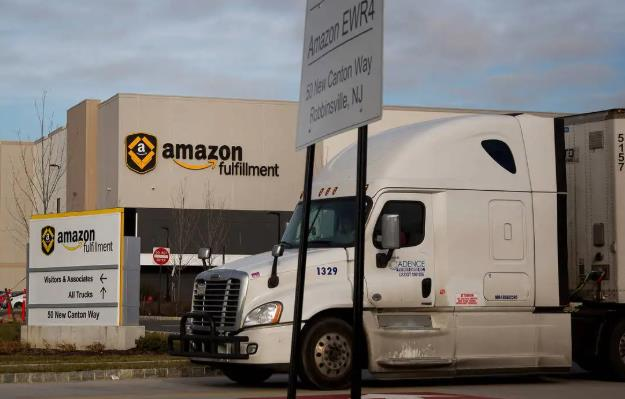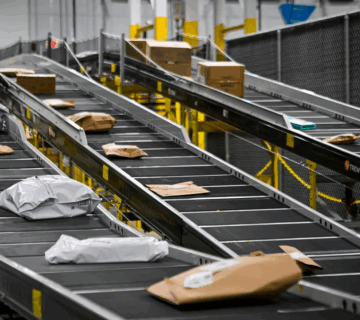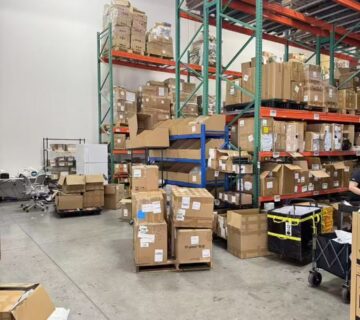Unlocking Success with Amazon Logistics: Your Guide to Seamless Delivery and Amazon Shipping
Amazon’s massive logistics network is the engine driving millions of deliveries daily. For sellers, understanding and effectively utilizing Amazon Logistics (AMZL) isn’t just beneficial – it’s crucial for success. Getting your products delivered by Amazon efficiently impacts everything from customer satisfaction to your bottom line. This article dives deep into the world of Amazon delivery, exploring how the system works, the options available, and importantly, how optimizing the entire supply chain, especially the critical steps before your products even reach an Amazon fulfillment center, can make all the difference. If you’re an Amazon seller, particularly one sourcing products from manufacturing hubs like China, understanding these nuances and partnering strategically can significantly boost your business. Read on to discover how to navigate this complex landscape and ensure your package delivery is seamless.
Article Outline:
- What Exactly is Amazon Logistics and Why Does It Matter for Your Business?
- How Does Amazon’s Delivery Service Actually Work from Click to Doorstep?
- Navigating the Labyrinth: What Are the Different Amazon Delivery Options Available?
- Who Are the Key Players? Understanding Amazon Delivery Service Partners (DSPs) and Amazon Flex
- Shipped with Amazon: What Does This Mean for Sellers and Customers?
- Are You Facing Challenges Getting Your Products to Amazon Fulfillment Centers Smoothly?
- How Can a Specialized Freight Forwarder Streamline Your Pre-Amazon Logistics?
- What Impact Does Optimized Upstream Logistics Have on Your Overall Amazon Success?
- Ready to Simplify Your China-to-Amazon Shipping? How Can We Help You Optimize Your Delivery Processes?
- Frequently Asked Questions (FAQs)
- Key Takeaways
What Exactly is Amazon Logistics and Why Does It Matter for Your Business?
Amazon Logistics, often abbreviated as AMZL, represents Amazon’s own end-to-end delivery network. It’s the infrastructure, technology, and personnel that Amazon uses to move packages from its fulfillment center locations directly to customer doorsteps. While Amazon also collaborates with traditional carriers like UPS, FedEx, and USPS, AMZL handles a significant and growing portion of its delivery volume, particularly last-mile deliveries. Think of it as Amazon taking control of its logistics operations to enhance speed, efficiency, and capacity.
Why does this matter profoundly for your business as an Amazon seller? Firstly, Amazon’s logistics network is built for speed and reliability, directly impacting the customer experience. Faster, more dependable delivery leads to higher customer satisfaction, positive reviews, and repeat business. Secondly, relying on Amazon’s logistics infrastructure often integrates seamlessly with Fulfillment by Amazon (FBA), simplifying the shipping process for sellers. Understanding how Amazon manages its delivery allows you to align your operations, manage inventory effectively, and meet customer expectations for fast delivery. Ultimately, leveraging Amazon’s logistics capabilities is key to competing effectively on the platform.
The sheer scale is astounding. Amazon’s global logistics network includes hundreds of fulfillment centers, sortation centers, and delivery stations, strategically located near major population hubs. They employ advanced logistics technology, robotics, and data analytics to optimize routes and predict demand. This constant innovation aims to make the delivery journey faster, cheaper, and more reliable. For sellers, this means access to a powerful logistics system, but it also underscores the importance of ensuring your products enter this system correctly prepared and compliant.
How Does Amazon’s Delivery Service Actually Work from Click to Doorstep?
The journey of an Amazon package is a marvel of modern logistics and delivery. It begins the moment a customer places an order. Sophisticated systems determine the optimal fulfillment center based on inventory location and the customer’s delivery address. Inside the fulfillment center, a complex dance of humans and robots retrieves the item, packs it securely, and applies the necessary shipping labels. This order processing stage is critical for ensuring accuracy and speed.
Once packed, the shipment moves to a sortation center. Here, packages are sorted based on their final destination and the chosen shipping method. This is where Amazon handles the transition to the appropriate transportation mode – whether it’s loading onto trucks for ground delivery, planes for faster International Air Transport, or potentially other methods depending on distance and urgency. Amazon utilizes a mix of its own fleet (including branded delivery vans and eventually Prime Air drones) and third-party carriers to move packages across its vast network.
The final, crucial stage is the last mile delivery. This involves getting the package from a local delivery station to the customer’s doorstep. This is often handled by Amazon Logistics drivers, Amazon Delivery Service Partners (DSPs), or Amazon Flex participants. Sophisticated routing software guides delivery drivers to ensure efficiency. Throughout this entire process, Amazon provides detailed tracking information, allowing both the seller (via their Amazon account) and the customer to monitor the package’s progress until it’s successfully delivered by Amazon.
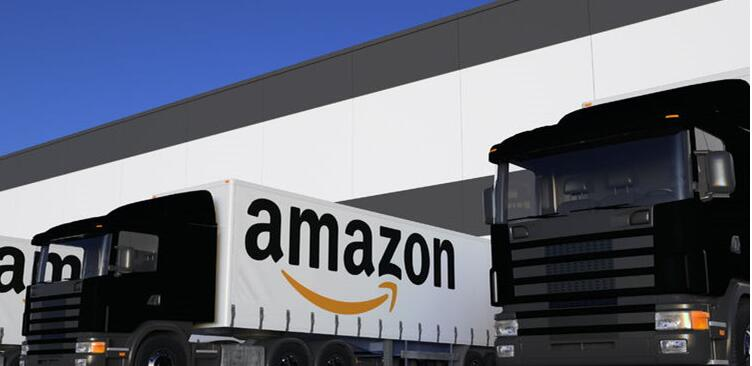
Navigating the Labyrinth: What Are the Different Amazon Delivery Options Available?
Amazon offers a diverse range of delivery options designed to meet varying customer needs for speed and convenience. The most famous is undoubtedly Amazon Prime, offering free two-day shipping on millions of items, along with increasingly common one-day and even same-day delivery in many areas. These expedited options have fundamentally reshaped customer expectations regarding delivery speed. Meeting these expectations is vital for maintaining competitiveness and customer satisfaction.
Beyond Prime, Amazon provides standard shipping options (typically 3-5 business days) for non-Prime members or for items not eligible for faster speeds. For added convenience, Amazon Lockers offer secure, self-service pickup points in various locations like grocery stores or convenience stores. Customers can select a locker during checkout and retrieve their Amazon package using a unique code. Furthermore, Amazon supports features like delivery windows, allowing customers in some areas to select a specific timeframe for their delivery, enhancing predictability.
Understanding these options is crucial for sellers using FBA. Your inventory placement within Amazon’s logistics network and your product’s eligibility directly impact which delivery options are available to customers viewing your listings. Faster shipping options often lead to higher conversion rates. Additionally, options like weekend delivery, which Amazon Logistics facilitates in many regions, ensure that the shopping experience doesn’t pause on Friday afternoon, allowing packages to deliver seven days a week and further improving the perceived speed and convenience for the amazon customer. The estimated delivery date shown to customers is a powerful factor in their purchasing decision.
Who Are the Key Players? Understanding Amazon Delivery Service Partners (DSPs) and Amazon Flex
While Amazon operates its own fleet and employs drivers directly, a significant portion of its last-mile delivery capacity comes from two key programs: Amazon Delivery Service Partners (DSPs) and Amazon Flex. These programs allow Amazon to scale its delivery capabilities rapidly and flexibly, especially in urban and suburban areas where delivery density is high. Understanding their roles helps paint a clearer picture of how Amazon manages its complex delivery processes.
Amazon Delivery Service Partners (DSPs) are independent small businesses that exclusively deliver packages for Amazon. Amazon provides access to technology, branded delivery vans, uniforms, and comprehensive training, enabling entrepreneurs to launch and manage their own delivery teams (typically 20-40 vans and 40-100 delivery drivers). DSPs operate out of Amazon delivery stations and are responsible for hiring and managing their teams to meet Amazon’s high standards for safety, reliability, and customer satisfaction. They are a cornerstone of Amazon’s logistics strategy for consistent, branded last-mile delivery.
Amazon Flex, on the other hand, operates more like a gig economy platform. Individuals use their own vehicles to sign up for delivery blocks, picking up packages from Amazon stations and delivering them to customers. Amazon Flex delivery offers flexibility for drivers and allows Amazon to quickly adjust its delivery capacity based on demand fluctuations, like during Prime Day or the holiday season. While both DSPs and Flex drivers are crucial service providers in the Amazon logistics ecosystem, they represent different operational models contributing to the overall goal: getting packages delivered efficiently. Amazon collaborates closely with both groups to ensure a smooth delivery experience.
Shipped with Amazon: What Does This Mean for Sellers and Customers?
When a customer sees the status “Shipped with Amazon” or notices their package arriving in an Amazon-branded van, it signifies that Amazon Logistics (AMZL) is handling the delivery, rather than a traditional third-party carrier like UPS or FedEx. This indicates that Amazon is utilizing its own internal logistics network for potentially part or all of the shipment journey, particularly the crucial last mile to the customer’s address.
For customers, “delivered by Amazon” often translates to reliable tracking information through their Amazon account or app, adherence to estimated delivery times (including potentially faster options like same-day or weekend delivery), and sometimes features like photo proof of delivery. It represents Amazon taking direct ownership of the delivery experience. This control allows Amazon has implemented various service enhancements and aims for a consistently high-quality service, which generally boosts customer satisfaction. They often request customer feedback specifically about the delivery experience handled by AMZL.
For sellers using FBA, “shipped with Amazon” means their products are flowing through Amazon’s logistics infrastructure. While sellers don’t typically choose the specific carrier, the performance of AMZL directly impacts their customers’ experience. Issues with delivery (though AMZL aims to minimize them) can reflect back on the seller’s reputation. This highlights why ensuring products are correctly prepped before reaching the fulfillment center is so vital. Smooth intake leads to smoother delivery, regardless of the final carrier. Reliable upstream logistics services contribute significantly to the positive downstream experience associated with “shipped with Amazon“.
Are You Facing Challenges Getting Your Products to Amazon Fulfillment Centers Smoothly?
While Amazon Logistics excels at the delivery from its fulfillment centers to the customer, many sellers, especially those sourcing products internationally, encounter significant hurdles before their inventory even reaches Amazon’s control. If you’re manufacturing goods in China, navigating the complexities of getting them prepared and shipped to an Amazon fulfillment center in the US, Europe, or elsewhere can be a major bottleneck. Are you struggling with coordinating cargo pickups from various manufacturing plants? Worried about product quality and consistency? Confused by Amazon’s strict packaging and labeling requirements? These initial steps in the supply chain are critical, and failures here can lead to delays, added costs, and inventory rejection by Amazon.
As a Chinese freight forwarder deeply experienced in the specific needs of Amazon Logistics sellers, we understand these challenges intimately. We see sellers grapple with:
- Cargo Collection: Managing pickups from multiple suppliers across different regions.
- Product Inspection: Ensuring goods meet quality standards before they are shipped internationally, preventing costly returns or negative reviews.
- Packaging Compliance: Repackaging products into boxes that meet Amazon’s size, weight, and durability requirements (Box Exchange).
- FBA Labeling: Correctly applying FNSKU labels, shipping labels, and any other required markings to ensure smooth check-in at the fulfillment center.
- Customs & Compliance: Navigating the paperwork and regulations for international shipping.
These aren’t just minor inconveniences; they are potential roadblocks to your success on Amazon. Getting these pre-FBA steps wrong means your products might not even make it onto the virtual shelves, let alone benefit from Amazon’s efficient delivery service.
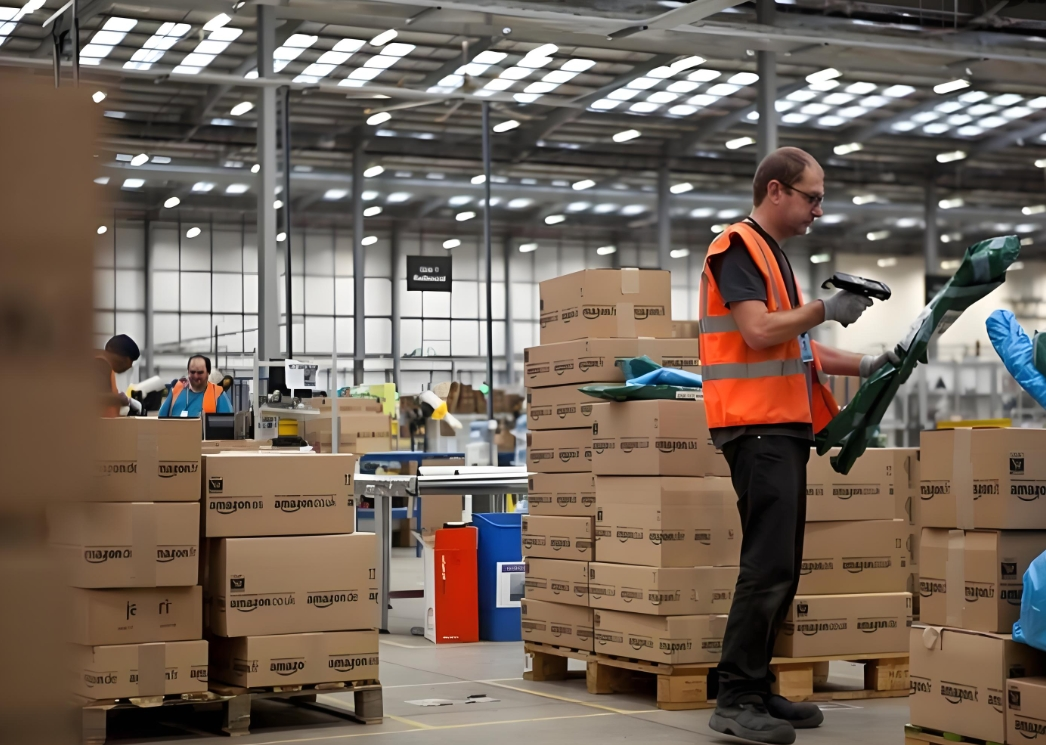
How Can a Specialized Freight Forwarder Streamline Your Pre-Amazon Logistics?
This is precisely where partnering with a specialized freight forwarder, like us, becomes invaluable. We bridge the gap between your manufacturing operations in China and Amazon’s logistics network. Think of us as your expert ground team, ensuring your products are perfectly prepared before they begin their journey to the FBA fulfillment center. Our tailored logistics services are designed specifically for the unique demands of Amazon Logistics sellers.
How do we optimize this crucial part of your supply chain?
- Consolidated Cargo Collection: We manage the collection of goods from your various suppliers across China, consolidating them at our facility for efficient processing and onward shipping. This saves you time and simplifies coordination.
- Rigorous Product Inspection: Before anything ships, we conduct thorough quality control checks based on your specifications. Identifying issues early prevents problems downstream, protecting your brand reputation and reducing returns.
- Expert Box Exchange & Repackaging: We understand Amazon’s strict packaging rules. We can repackage your products into compliant cartons, ensuring they meet size, weight, and durability standards, preventing rejection or penalties at the fulfillment center.
- Accurate FBA Labeling: We handle the precise application of FNSKU labels, ‘Sold as Set’ labels, suffocation warnings, and required shipping labels, ensuring your inventory is processed quickly and accurately upon arrival at Amazon. This directly impacts your inventory management.
- Flexible Shipping Solutions: We offer a range of international logistics services, including cost-effective International sea Transport for bulk shipments, faster International Air Transport, and even efficient International rail Transport or International road Transport options where applicable, tailoring the solution to your budget and timeline.
- Drop Shipping Coordination: For certain models, we can even coordinate drop shipping directly from the manufacturing source after ensuring quality and proper preparation.
By entrusting these critical pre-FBA steps to us, you eliminate major logistical headaches, reduce shipping complexities, ensure compliance, and free up your time to focus on growing your Amazon business. We act as an extension of your team, dedicated to making your inventory management and shipping process smooth and efficient.
What Impact Does Optimized Upstream Logistics Have on Your Overall Amazon Success?
The benefits of streamlining the logistics before your products hit the Amazon fulfillment center extend far beyond just avoiding penalties. Optimizing these initial steps, especially with a partner who understands both Chinese manufacturing and Amazon Logistics requirements, creates a positive ripple effect across your entire operation. When your products arrive at Amazon correctly packaged, labeled, and quality-checked, they get checked in faster. This means your inventory becomes available for sale sooner, reducing stockout risks and maximizing potential sales, particularly during peak periods like Prime Day.
Faster inventory processing translates directly into eligibility for faster delivery options like Amazon Prime. Customers are significantly more likely to purchase products offering quick, reliable delivery, giving you a competitive edge. Furthermore, by ensuring product quality before shipment through rigorous inspection, you drastically reduce the likelihood of negative customer reviews, returns, and the associated costs. This protects your seller metrics and enhances customer satisfaction. Think about the long-term impact: consistent product availability, fast shipping, and high quality lead to loyal customers and sustainable growth.
Ultimately, partnering with a specialized freight forwarder like us helps you optimize your logistics strategy from end-to-end. While Amazon takes care of the delivery from their centers, ensuring the input into their system is flawless is your responsibility – and our expertise. It leads to:
- Improved Cash Flow: Faster inventory turnover.
- Reduced Costs: Avoiding repackaging fees, storage penalties, and return costs.
- Enhanced Customer Satisfaction: Through faster delivery speed and reliable product quality.
- Better Seller Metrics: Protecting your Amazon account health.
- Competitive Advantage: Standing out with reliable stock and efficient shipping.
Investing in smooth upstream logistics isn’t an expense; it’s a strategic investment in your Amazon success.
Ready to Simplify Your China-to-Amazon Shipping? How Can We Help You Optimize Your Delivery Processes?
Navigating the journey from a manufacturing plant in China to a happy Amazon customer requires mastering two distinct logistical phases: the critical pre-FBA preparation and shipping, and Amazon’s powerful fulfillment and delivery network. While Amazon handles the final stages exceptionally well, optimizing the first phase is where many sellers encounter friction. As a dedicated Chinese freight forwarder specializing in Amazon Logistics, we are uniquely positioned to eliminate that friction for you. We offer comprehensive shipping solutions designed specifically for Amazon sellers sourcing from China.
Are you tired of coordinating multiple suppliers? Worried about unexpected quality issues reaching your customers? Struggling with FBA prep requirements? We are here to help. Our services – including cargo collection, product inspection, box exchange, FNSKU labeling, and arranging international freight – are designed to ensure your products arrive at Amazon fulfillment centers perfectly prepared for seamless integration into the Amazon logistics system. We act as your boots-on-the-ground partner in China, providing the expertise and infrastructure needed to streamline your delivery processes right from the source.
Let us handle the complexities of getting your products FBA-ready, so you can focus on scaling your business. We work closely with you to understand your specific needs and tailor our logistics services accordingly. Partnering with us means:
- Peace of mind: Knowing your products are inspected and prepped correctly.
- Efficiency: Faster turnaround from factory to fulfillment center.
- Cost savings: Avoiding costly errors, delays, and penalties.
- Expertise: Leveraging our deep understanding of both Chinese manufacturing and Amazon’s requirements.
Take the first step towards a smoother, more efficient supply chain. Contact us today to discuss your specific needs and discover how our specialized International logistics services can empower your Amazon business. Let’s work together to optimize your path from production to package delivery.
Frequently Asked Questions (FAQs)
How does Amazon ensure fast delivery times like same-day or two-day shipping?
Amazon achieves fast delivery through a combination of strategically placed fulfillment center locations, sophisticated inventory placement algorithms, advanced logistics technology for route optimization, and a vast delivery network including its own fleet (Amazon Logistics), DSPs, Amazon Flex drivers, and partnerships with traditional carriers. Amazon Prime membership subsidizes these expedited shipping times for eligible items.
Can I choose which carrier delivers my Amazon package?
Generally, customers and sellers cannot choose the specific carrier (like AMZL, UPS, FedEx) for their delivery. Amazon’s system automatically selects the most efficient and cost-effective shipping method based on factors like warehouse location, destination, package size/weight, and selected delivery speed. The focus is on meeting the promised estimated delivery date reliably.
What happens if I’m not home for an Amazon Logistics delivery?
Amazon Logistics drivers have several options if you’re not home. They may leave the package in a safe place (porch, designated spot), leave it with a neighbor if you’ve authorized it, or leave a “sorry we missed you” notice with instructions for redelivery or pickup. Depending on the area and service, they might attempt delivery again later that day or the next business day. Using Amazon Lockers can prevent missed delivery attempts. You can often provide specific delivery instructions in your Amazon account.
How does Amazon handle delivery challenges like bad weather or high volume periods like Prime Day?
Amazon’s logistics network has built-in flexibility to manage delivery challenges. During peak times like Prime Day or holidays, they increase staffing, leverage Amazon Flex for extra capacity, and adjust delivery windows. For bad weather, safety is prioritized; delivery processes might be temporarily halted or delayed, and tracking information is usually updated accordingly. Their advanced technology helps predict and mitigate potential disruptions to deliver packages as reliably as possible.
Does Amazon Logistics deliver on weekends?
Yes, in many areas, Amazon Logistics (AMZL) provides weekend delivery services, including both Saturdays and Sundays. This is a significant part of their effort to offer faster and more efficient deliveries and meet customer expectations for convenience, ensuring packages keep moving seven days a week. Availability of deliveries on weekends depends on the specific location and the shipping option selected.
How can I track my package when it’s shipped with Amazon Logistics?
You can easily track your Amazon package handled by Amazon Logistics. Use the tracking number provided in your shipping confirmation email or directly within your Amazon account under “Your Orders.” Amazon provides a detailed tracking system that shows the package’s progress from the fulfillment center to your doorstep, often including real-time map tracking on the day of delivery to help you locate your package.
Key Takeaways: Mastering Amazon Logistics
- Amazon Logistics (AMZL) is Amazon’s own extensive delivery network, crucial for fast and reliable package delivery.
- The delivery process involves sophisticated order processing, fulfillment center operations, multi-modal transport, and efficient last-mile delivery via DSPs and Amazon Flex.
- Understanding delivery options (Prime, Same-Day, Lockers, Weekend Delivery) helps manage customer expectations.
- The “Shipped with Amazon” status indicates AMZL is handling the delivery, aiming for high customer satisfaction.
- Critical challenges often lie before products reach Amazon, especially for sellers sourcing internationally (e.g., from China).
- Partnering with a specialized freight forwarder (like us!) for pre-FBA steps (inspection, labeling, box exchange, cargo collection) is vital to optimize your supply chain.
- Streamlined upstream logistics leads to faster inventory check-in, better delivery speed, reduced costs, higher customer satisfaction, and overall business success.
- Focusing on efficient pre-Amazon preparation directly improves the effectiveness of Amazon’s logistics for your products. Contact us to learn how our International Logistics expertise can help.
